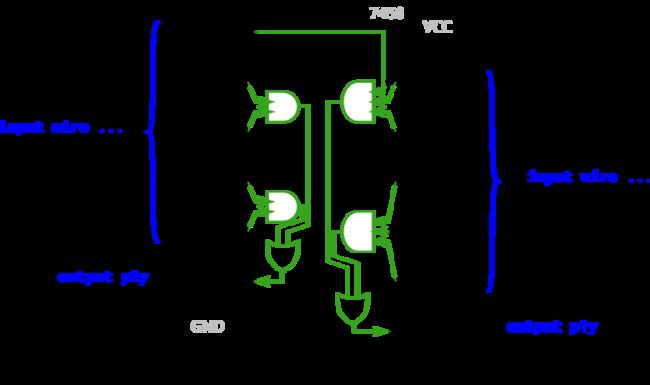HDLBits刷题合集—2 Basics
HDLBits刷题合集—2 Basics
HDLBits-2 Zero
Problem Statement
建立一个没有输入只有输出常数0的电路。
代码如下:
module top_module ( output zero );
assign zero = 1'b0;
endmodule
HDLBits-3 Wire
Problem Statement
创建一个具有一个输入和一个输出的模块,其行为类似于线。
代码如下:
module top_module( input in, output out );
assign out = in;
endmodule
HDLBits-4 Wire4
Problem Statement
创建一个有3个输入和4个输出的模块,它的行为就像这样连接的线:
a -> w
b -> x
b -> y
c -> z

代码如下:
module top_module(
input a,b,c,
output w,x,y,z );
assign w = a;
assign x = b;
assign y = b;
assign z = c;
endmodule
HDLBits-5 Notgate
Problem Statement
创建一个实现非门的模块。
module top_module( input in, output out );
assign out = ~in;
endmodule
HDLBits-6 Andgate
Problem Statement
创建一个实现与门的模块。
代码如下:
module top_module(
input a,
input b,
output out );
assign out = a & b;
endmodule
HDLBits-7 Norgate
Problem Statement
创建一个实现或非门的模块。或非门是输出反相的或门。当用Verilog编写NOR(或非)函数时,它需要两个操作符。

代码如下:
module top_module(
input a,
input b,
output out );
assign out = ~ (a | b);
endmodule
HDLBits-8 Xnorgate
Problem Statement
创建一个实现XNOR(同或)门的模块。
代码如下:
module top_module(
input a,
input b,
output out );
assign out = a ^~ b;
endmodule
HDLBits-9 Wire declare
Problem Statement
到目前为止,电路已经足够简单,输出是输入的简单函数。随着电路变得越来越复杂,你将需要电线把内部元件连接在一起。当你需要使用连线时,你应该在第一次使用它之前,在模块的主体中声明它。(将来,您将遇到更多类型的信号和变量,它们也是以同样的方式声明的,但是现在,我们将从wire类型的信号开始)。
module top_module (
input in, // Declare an input wire named "in"
output out // Declare an output wire named "out"
);
wire not_in; // Declare a wire named "not_in"
assign out = ~not_in; // Assign a value to out (create a NOT gate).
assign not_in = ~in; // Assign a value to not_in (create another NOT gate).
endmodule // End of module "top_module"
实现以下电路。创建两个中间线(命名任何你想命名的名称,关键字除外),将与门和非门连接在一起。注意,提供非门的连接实际上是连接出去的,所以不必在这里声明第三个wire。注意线是如何由一个源驱动的(一个门的输出),但可以提供多个输入。如果你遵循图中的电路结构,你应该以四个赋值语句结束,因为有四个信号需要赋值。
`default_nettype none
module top_module(
input a,
input b,
input c,
input d,
output out,
output out_n );
wire and1,and2;
assign and1 = a & b;
assign and2 = c & d;
assign out = and1 | and2;
assign out_n = ~( and1 | and2);
endmodule
HDLBits-10 7458
Problem Statement
7458是一个有四个与门和两个或门的芯片。这个问题比7420稍微复杂一些。
创建与7458芯片具有相同功能的模块。它有10个输入和2个输出。您可以选择使用一条assign语句来驱动每条线,也可以选择声明4条线用作中间信号,其中每条内部线由其中一个与门的输出驱动。对于额外的练习,两种方法都可以尝试。

代码如下:
module top_module (
input p1a, p1b, p1c, p1d, p1e, p1f,
output p1y,
input p2a, p2b, p2c, p2d,
output p2y );
/*
wire and21,and22,and11,and12;
assign and11 = p1a & p1b & p1c;
assign and12 = p1d & p1e & p1f;
assign and21 = p2a & p2b;
assign and22 = p2c & p2d;
assign p1y = and11 | and12;
assign p2y = and21 | and22;
*/
assign p1y = (p1a & p1b & p1c) | (p1d & p1e & p1f);
assign p2y = (p2a & p2b) | (p2c & p2d);
endmodule
Note
新手一枚,主要分享博客,记录学习过程,后期参考大佬代码或思想会一一列出。欢迎大家批评指正!





